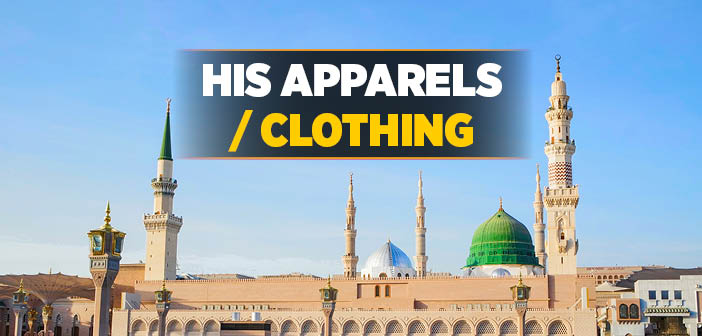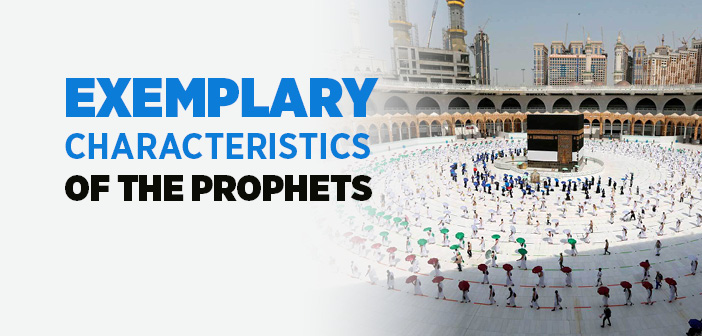What clothing did prophet muhammad wear? What did prophet muhammad say about clothing?
Just like all of other aspects of the Prophet’s life, his apparels were matters of interest for his wives, other companions, and for the entire Muslim community. This is why what he wore or did not wear; what he suggested to wear or warned about wearing have been carefully studied.
a. His Turban
Allah’s Messenger (pbuh) often wore a hat called “qalansuwah,” rolled his turban around it, and swung its one end between his shoulders. (Tirmidhi, Libas, 12) He wore his turban constantly and stated that the turban was apparel also worn by the angels. According to reports, on the night of ascension the Prophet (pbuh) had seen most of the angels wearing turbans. (Haythami, V, 120)[1]
Allah’s Messenger (pbuh) often wore a white turban. He also advised his followers to wear white apparel in general. (Tirmidhi, Adab, 46) According to the reports, the Prophet (pbuh) entered Mecca after the conquest wearing a black turban and during his victory speech he wore the same black turban. (Muslim, Hajj, 451) It is also reported that he sometimes dyed his turban in yellow by saffron. (Ibn Sa’d, I, 452; Ibn Abi Shaybah, V, 160)
b. His Clothes
The Messenger of Allah (pbuh) used to wear two pieces of clothing. The one which was worn above the waist is called “rida” and the one worn below the waist is called “izar.” (Ibn Sa’d, I, 452) In the traditions of the Prophet (pbuh), the term “thawban or two pieces of clothes” is used for these clothes. (Abu Dawud, Libas, 19) However, the clothing which Allah’s Messenger (pbuh) liked best was a shirt called “qamis”, which was a long shirt that reached his feet. (Abu Dawud, Libas, 3) In addition to those, he would sometimes wear a cloak or vest like apparel over his daily clothes. (Ibn Sa’d, I, 450, 451, 453, 461) It is also reported that he sometimes wore something like baggy trousers called “sirwal.” (Haythami, V, 121)
Allah’s Messenger also had clothes for special occasions. For instance, he used to wear a red gown on Fridays; and there are also reports about a dress made in Hadhramaut that he wore when welcoming foreign delegates. (Ibn Sa’d, I, 451, 458) Besides his daily apparel, the Prophet (pbuh) also had special clothes that he wore at night. (Hamidullah, II, 1077)
As for the materials of the Prophet’s clothes, we know that in accordance with the circumstances that he sometimes wore clothes made from cotton and wool, and sometimes he wore clothes made from thick animal hair. (Abu Dawud, Libas, 5) These clothes were in different colors like white, black, yellow, green, and red. (Ibn Sa’d, I, 449-56) However, the Prophet (pbuh) preferred and advised his followers to wear white colored clothes when it is possible. In fact, in one of his sayings he advised that not only should the living believers wear white colored clothes but also the dead ones as follows:
“Wear white clothes, since white clothes are cleaner and better in appearance. Shroud your dead in white, too.” (Tirmidhi, Adab, 46) In this saying, he also points out that the primary and important requirement in clothes is their cleanliness.
Allah’s Messenger (pbuh) did not like to have a bad smell on his clothes. Once he wore a black wool cloak. When he sweated in it and noticed the odor of the wool, he threw it away. Aisha (r.a.), who narrated this tradition, told us that the Prophet (pbuh) always liked nice fragrances. (Abu Dawud, Libas, 19)
The Messenger of Allah (pbuh) refrained from wearing clothes which may attract too much attention or lead to vanity. Once he had worn a silk dress which was given to him by the Emperor of Byzantine as a gift. However, it attracted so much attention that companions asked the Prophet (pbuh) whether it was sent down from the heavens. Then he never wore it again and sent it to Negus Ashama as a gift. (Ibn Sa’d, I, 456, 457)
First, Allah’s Messenger had worn silk clothes, but later he stopped wearing them and forbade wearing silk to the male members of his community. The Prophet of Allah (pbuh) took silk and held it in his right hand, and took gold and held it in his left hand and said:
“Both of these are prohibited to the males of my community.” (Abu Dawud, Libas, 11)
On the other hand, Allah’s Messenger (pbuh) had never been desirous to throw away his old clothes and wear the new ones. He sometimes even wore patched, old, and almost colorless clothes. Qayla bint Mahramah narrates: “When I saw the Prophet (pbuh), he was wearing a two-piece cloth, which looked like a piece of sheet, dyed with saffron; but its color was fading because of oldness.” (Tirmidhi, Adab, 50) Again according to the narration of Aisha (r.a.), when the Prophet (pbuh) passed away, he had been wearing two pieces of clothes, one of them was patched and the other one was pretty rough. (Muslim, Libas, 35; Tirmidhi, Libas, 10)
c. His Socks and Shoes
Allah’s Messenger (pbuh) wore different types of socks and shoes in accordance with his means and the conditions of the place. (Abu Dawud, Taharah, 62; Tirmidhi, Taharah, 74)
He wore shoes called “na’lain” and a type of socks called “khuffain.” According to Buraidah (r.a.) the Emperor of Abyssinia sent the Prophet (pbuh) a pair of black, plain and seamless khuffain. Allah’s Messenger (pbuh) wore them while he was in ritual purity; and then he did not wash his feet but just wiped over them while performing ablution. (Abu Dawud, Taharah, 60) According to another narration, Dihyat al-Kalbi gave the Prophet (pbuh) a pair of khuffain and a cloak as a gift, and he kept wearing them until they were completely worn out. (Tirmidhi, Libas, 30)
The Prophet’s socks called khuffain were not like regular socks which are worn with shoes, but a type of foot wear which can be worn separately like a pair of boots. In time the khuffain has turned into leather socks maybe because of its easiness in performing ablution.
The other type of shoes that was worn by Allah’s Messenger (pbuh) was called na’lain and it was similar to sandals. It had a bridge-like strap on it. Another apparent characteristic of these shoes was that it had a lace called iqal, which was attached to the strap. The material used for its production was a tanned hide.
Ibn Abbas (r.a.) narrates: “Prophet’s na’lain had two qibals[2] and its straps were two folded.” (Ibn Majah, Libas, 27)
Abdullah b. Umar (may Allah be pleased with them) said: “I saw Allah’s Apostle wearing leather shoes that had no hair, and he used to perform the ablution while wearing them. Therefore, I like to wear such shoes.” (Bukhari, Libas, 37; Muslim, Hajj, 25)
d. His Ring and Seal
In the sixth year of migration after migrating from Mecca to Medina and gathering believers under a political unity, Allah’s Messenger (pbuh) wanted to write letters to the neighboring states and invite them to Islam. It was said to him, “They do not accept any letters unless they are stamped.” So the Prophet had a silver ring made for himself.” (Bukhari, Libas, 50)
The Arabic word for the ornament that we have translated as seal is “khatam”. It also means “a ring.”In fact, the Prophet’s seal was in the shape of a ring. This seal which was called “Khatam al-Nabi – Seal of the Prophet” or “Khatamu Rasulillah – Seal of the Messenger of Allah” was made from silver, and its stone was of silver too.” (Bukhari, Libas, 48) There were three words engraved upon the ring. The engraving was in three lines: ‘Muhammad’ in one line, ‘Messenger’ in another line, and ‘Allah’ in a third line. (Bukhari, Libas, 55)
Some companions wanted to have a similar ring made for themselves, but the Prophet (pbuh) forbade them saying: “no one is allowed to have a ring which is engraved with the inscription of my seal.” (Ibn Hanbal, III, 290)
After the death of the Prophet (pbuh), the seal of the Messenger of Allah was passed on to Abu Bakr, Umar, and Uthman (may Allah be pleased with all of them) respectively. However, in the sixth year of Uthman’s caliphate it fell into the well called Eris in Medina and got lost. (Bukhari, Libas, 50)[3]
e. His Cleaning Equipment and Ornaments
Allah’s Messenger (pbuh) paid close attention not only his hygiene but also to tidiness. He would comb his hair and beard whenever it was necessary; dye his hair with henna and anoint it with olive oil. (Tirmidhi, Shamail, p. 18-27) He would never neglect to clean his teeth and frequently would brush them with a tooth-stick during the day. (Muslim, Taharah, 42) It is also recorded that the Prophet (pbuh) used to tinge his eyes with kohl before going to bed.[4] Nice fragrances also had a special place in the Prophet’s life for it was one of the three things he loved. Anas b. Malik (r.a.) narrated:
“Allah’s Messenger (pbuh) had a perfume bottle with which he perfumed himself.” (Abu Dawud, Tarajjul, 2)
On the other hand, Allah’s Messenger (pbuh) would not approve to spend too much time for caring for one’s hair and clothes; and he stated that just like cleanliness, plainness of the garments was a part of faith. (Abu Dawud, Tarajjul, 1) Indeed we find out that his equipment for taking care of his hair and clothes were very simple. Among them were a mirror, comb, scissors, tooth-stick, a container for kohl, a bottle or a box for perfume, and muslin. (Ibn Sa’d, I, 484)
The Prophet (pbuh) would also take these equipments with him to his journeys. (Ibn Sa’d, I, 484)
f. His Rides
There were some rides used by the Messenger of Allah (pbuh). The camel named Quswa, which the Prophet (pbuh) rode during his migration to Medina, was very famous. The Prophet (pbuh) also owned a horse named Sakb that he rode for the first time in the Battle of Uhud. He had other horses given to him as presents by his companions. His mule named Duldul and his donkey named Ya’fur were among his well-known rides. (Ibn Sa’d, I, 489-92)
g. His Armaments
Besides the daily garments of the Messenger of Allah (pbuh), he also owned equipment as a commander to use on the battle field, such as armor, a sword, and a helmet.
His armor was a vest made from entwined small rings, which protected him from enemy attacks. Allah’s Messenger (pbuh) wore such armor especially in the Battles of Uhud and Khaibar. The Prophet’s vests had different names such as dhat’ul fudul, su’adiyah, fidda, batra, and harnaq. (Zahabi, al-Sirah, I, 430) The Prophet (pbuh) died while his iron armor was mortgaged to a Jew for some barley. (Bukahri, Jihad, 89)
The Prophet (pbuh) was wearing a helmet while entering Mecca on the day of the conquest. (Bukhari, Jihad, 169)
Among the weaponry of the Prophet (pbuh), there were his swords which were named zulfikar, kala’i, battar, and hatf. Zulfikar which had been taken as war booty in the Battle of Badr was a well-known sword. In fact, it has been part of the following proverb: “La sayfa illa zulfikar wa la fata illa Ali – there is no sword except zulfikar and there is no brave man except Ali” (Ajluni, II, 506)
The Prophet (pbuh) possessed three bayonets and three bows. In fact, it is reported that his bows were named rawha, bayza, and safra. He also had a shield with a picture of a ram on it, but he had this picture erased from his shield for he did not like depictions. (Ibn Sa’d, I, 479)
In short, in this section of this book about the garments and equipment of the Prophet (pbuh), it appears that in this respect Allah’s Messenger (pbuh) preferred plainness as he did in every other aspect of his life. He did not act like a king who possessed all kinds of means.
[1] It is known that Allah’s Messenger’s head was always covered and he always performed his prayers with his head covered. This is why Muslim jurists have considered that it is reprehensible for a believer not to cover his head because of laziness or negligence; because, it was the tradition of the Prophet (pbuh). The command in the verse (7; 31) about wearing embellishments at the places of worship also includes the covering of heads for males. This is why wearing a skullcap during prayer is considered as something recommended by all the schools of Islamic law. Thus, covering the head with a skullcap or something similar in a way that does not hinder the prostration is more virtuous. If someone drops his skullcap during prostration, it is even recommended to pick it up without making too many moves. However, a believer is also allowed to not wear a head cover during prayer because of an excuse or because of modesty and piety. (Kawthari, p. 258-59; Hamdi Döndüren, p. 270-71)
[2] Qibal is a cord, which attaches the bottom of a sandal and goes between the middle toe and the one next to it.
[3] A story is told about the losing the seal of the Prophet (pbuh). According to the story, the Prophet’s seal had some secrets hidden in it like the seal of the Prophet Solomon. When the seal of the Prophet Solomon got lost, his reign shook and then collapsed. Similarly, when the Prophet’s seal got lost during Uthman’s caliphate, unrest began in the government, rebels from Egypt and Iraq revolted and the unrest, which led to the Caliph’s assassination, could not be stopped. (Ali Yardım p. 145)
[4] The Messenger of Allah (pbuh) suggested that his followers use a type of kohl, which is made from a stone called ismid. He expressed that this was good for the eyes and the eyelashes. (Tirmidhi, Libas, 23)
Source: An Excellent Exemplar, Osman Nuri Topbaş, Erkam Publications





